


Advertisement


One of the most remarkable things about light is its speed. At 299,792,458 meters per second - very close to 300,000
kilometres or 186,300 miles per second - it's the fastest thing there is. Nothing, no matter how hard it tries, can go any
faster. The speed of light is certainly very impressive, but it has another quality that is even more remarkable. In free
space (i.e. a vacuum) its speed is constant. At first this doesn't seem all that odd, but, as we shall see, it's actually one of
the strangest things in the universe. Before we can appreciate the significance of the speed of light being constant we
need to learn a little more about light itself.
The Electromagnetic Spectrum
The word "light" has a more complex meaning in physics than it does in everyday life. The light we see by is referred to
as "visible light" and is a small part of the electromagnetic spectrum. Radio waves, X-rays and microwaves are all part
of the same electromagnetic spectrum. The difference between visible light and all the other forms of electromagnetic
radiation is in the magnitude of the wavelength of the light. Light can be thought of as travelling in waves, the distance
between any two crests of the wave being the wavelength:
Each different colour that we can see has its own particular wavelength. For example, red light has a has a longer
wavelength than blue light. White light, similar to the light we get from the Sun or a light bulb, is a mixture of all the
different colours we can see.
If we take a look at a section of the electromagnetic spectrum we can see that the visible light our eyes are sensitive to
forms only a small part of the total "kinds" of light we can makes use of:
The wavelength of any wave is related to its frequency (that is, if the wave is moving, the number of crests that pass a
stationary point in a second) and its speed. These three quantities are related by the equation:
An explanation of this equation plus worked examples is available here.
We now have the tools we need to examine some of the more interesting properties of light waves.
The Doppler Effect

Water waves, sound waves and light waves all share a number of properties, including what is known as the Doppler
Effect. This says that when a wave is approaching us the length of each individual wave is compressed and when the
wave is moving away from us the length of each individual wave is stretched out. For sound waves this manifests itself
as a rise in pitch (i.e. frequency) for an approaching wave and a decrease in pitch for a receding wave. This is why we
hear the siren of a police car change pitch as it passes us:
As we have noted, the speed, frequency and wavelength of a wave are all mathematically related. If we know any two of
the three parameters we can calculate the third. For example, the speed of the wave is calculated from a rearrangement
of the equation we saw in the previous section:
In fact, it is this equation and the Doppler effect that are behind the "speed trap guns" used by police forces. "Light"
entering the gun has its frequency measured against a set value. The difference in the two frequencies is fed into a
modified form of the above equation and a speed is calculated.
While water and sound waves don't have constant speeds we've said that light does. So how can the police speed gun
detect our speed? We know that the speed of the light stays the same so it must be the wavelength and therefore the
frequency that changes. This manifests itself as a change in the colour of the light. The change is far too small to be seen
with the naked eye, but quite easy to detect using electronic equipment, such as a speed trap gun.
As a light wave approaches us its frequency is "shifted" towards the blue part of the spectrum. That is, if the light was
white to begin with it will now have its wavelength compressed in such a way that it begins appear blue. Likewise, if the
light is moving away from us it will appear red because its wavelength is stretched and its frequency is correspondingly
lower than before. It's only when the light source is stationary that we can see what colour it really is.
The wavelength of each colour of light is different
We can use the Doppler effect of moving light sources to establish something quite extraordinary about the speed of light,
and the universe.
An impossible Result?
In the mid-1800s the physicist James Clerk Maxwell discovered the theoretical basis behind electromagnetism. His work
was so good that it's still used today in the design of electric motors and a thousand other items that we take for granted.
Your computer probably has at least one electric motor driving the hard disk drive and maybe another for a CD or DVD
drive. Even in his day Maxwell's equations on electromagnetism were seen as very far reaching and of practical use in any
number of applications. There was, however, a problem.
Every time Maxwell rearranged his equations to make the speed of light the subject and plugged in the numbers he got a
very strange result. The speed of light always came out the same, regardless of the speed of the light source. This result
seemed absurd! It's common sense that anything cast from a moving body will have a speed that's calculated from both
the moving body and the object.
For example, the speed of a bullet is often said to be twice the speed of sound, that is, around 1500 mph. This is only true
if the gun that fired the bullet is stationary. If we put the gun on an aeroplane flying at 500 mph it's obvious that the initial
speed of a bullet as it leaves the gun is now 1500 mph + 500 mph = 2000 mph relative to a stationary observer:
What Maxwell's equations seemed to be showing was that light didn't behave like this, at least in theory. Instead the
equations stated that the speed of light was the same no matter what the speed of the source. In other words it wasn't
possible to add or subtract the speed of the object carrying the light source:
This result was so strange that it was seen as an embarrassment in an otherwise sound and well tested theory. No one
accepted its conclusions at face value and it was thought only a matter of time before a better theory was found which
showed light to behave the way everyone expected it to.
For the sake of completeness I will include the equation, as derived by Maxwell, that is now accepted as the correct
theoretical basis for calculating the speed of light:

While a full explanation of this equation is outside the scope of these pages a few words are perhaps instructive. We have
said that light is part of the electromagnetic spectrum. The permittivity of free space is otherwise known as the electric
constant and is derived from the force of electricity felt by two electrically charged particles in a vacuum. The permeability
of free space is known as the magnetic constant and is derived from the magnetic force felt on an object in a magnetic
field. Light is a combination of both of these constants; it is both electric and magnetic, hence light is electromagnetic.
Another impossible Result?
Towards the end of the 19th Century it was fondly thought that the work of the world's physicists was almost complete.
There were only a few odds and ends to tie up and that would be the end of the matter. One of these odds and ends was
the rather annoying prediction in Maxwell's equations that the speed of light was constant, and many people set out to
show that this was the nonsense it seemed to be. No one really believed that the speed of light could possibly be constant
and it was just a matter of finding some experimental evidence to show that light behaved the way everyone expected it to.
In 1887 two particularly ingenious experimental physicists conducted an experiment to measure the speed of light
changing as a consequence of the Earth travelling around the Sun. This experiment would use the Doppler effect as its
basis. The physicists were the Americans Albert Michelson and Edward Morley, and they are now, sadly, almost always
remembered for all the wrong reasons.
Around this time it was thought, and widely accepted, that space was filled with a transparent substance called the "ether".
It was this, it was thought, that allowed light waves to get from place to place, just as air allows sound to travel (note that
sound can't travel in a vacuum). The arguments for the ether were so strong that we still refer to it today. For example, we
talk of radio waves travelling through the ether, and it wasn't such a long time ago that many computers were connected to
networks by the Ethernet.
Using a series of mirrors and an instrument for measuring the wavelength of light (called an interferometer) the two
scientists carried out what is now referred to as the Michelson-Morley Experiment. They expected, as did everyone else,
that they would find that the Earth's rotation around the Sun would show up as a colour shift in the (stationary) ether due to
the speed of light being added to the Earth's speed in the direction of orbit, and subtracted in the direction that the Earth
was moving away from:
What they found however just didn't seem to make sense. Their results showed that there was no difference in the speed
of light in either direction. Not only that, but they couldn't actually detect the ether at all! Everyone, including Michelson
and Morley, put this down to experimental error. The equipment was improved and the experiment tried again. Still the
results came out the same; the speed of light seemed to be constant! In fact, the experiment was carried out a number of
times, each time with improved equipment and every time the results came out the same.
With hindsight it's easy to criticise the whole scientific community for not seeing what was staring them in the face. This
would be quite unfair, however. They were being asked to believe something that challenged not only all of the very
successful scientific doctrine of the previous 200 years, but also common sense itself. However, there is no evidence that
the universe is constructed in such a way that it always has to make sense to mere humans beings! Just occasionally
though, there are human beings who look at the universe a little differently.

Enter Albert Einstein
In 1905 Albert Einstein was working as a patent clerk in Switzerland. He always claimed he new nothing of the Michelson
and Morley experiments and this is quite possibly true; Einstein's physics were usually carried out without reference to
experimental results. Instead he relied on his own intuition and mathematical experimentation. His isolation from the
physics community was probably a bonus in that he was allowed to think freely without being swayed by contemporary
ideas or doctrine.
Einstein started by asking the almost child-like question "what would it be like to ride on a light beam?" The answer to this
simple question eventually led him to deduce his Theory of Relativity. In order for his ideas and equations to make any
sense he had to do something no one had dared to do before – he had to accept the constancy of the speed of light at
face value. Once this is done the constancy of the speed of light is one of only two postulates needed for the whole of
special relativity:
Postulate I: The principle of relativity:
The laws of physics are the same in same in all inertial frames.
Postulate II: The principle of the constancy of the speed of light:
The speed of light (in a vacuum) has the same constant value c in all inertial frames.
The whole of special relativity; time dilation, the twin paradox, moving clocks running slowly, space-time and even E = mc
2
all stem from just these two postulates. Once the speed of light is accepted as a constant, as it had already been seen to
be both in theory and experiment, everything slots into place. That the speed of light is constant has been checked over
and over again using ever more sophisticated equipment.
Probably the most startling demonstration of the second postulate being correct is the detonation of an atomic bomb.
Whatever one thinks of the merits of such devices it's undeniable that they work. The basic principle behind an atomic
bomb is that matter is converted into energy via the famous equation E = mc
2
. This equation is derived directly from the
second postulate. There are few more convincing ways in which a "theory" can be demonstrated to be correct.
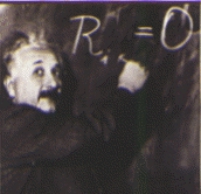
Albert Einstein (1879 – 1955)


Bullet speed = 1500 mph
Jet speed = 500 mph
Bullet speed = 1500 mph
Total bullet speed = 2000 mph
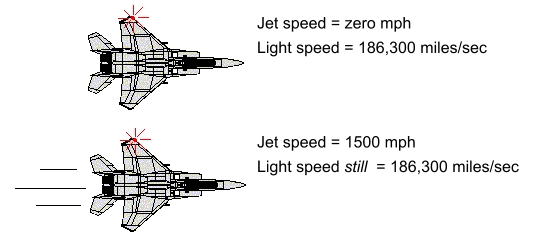
Addition of normal speeds
The speed of light remains constant
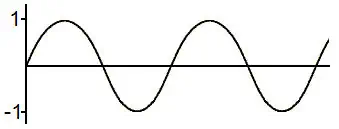

Wavelength
The wavelength of a wave
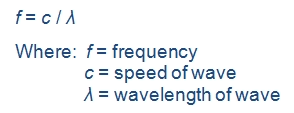
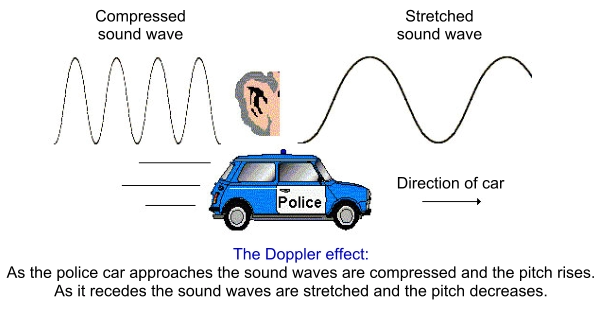
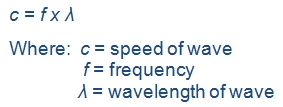
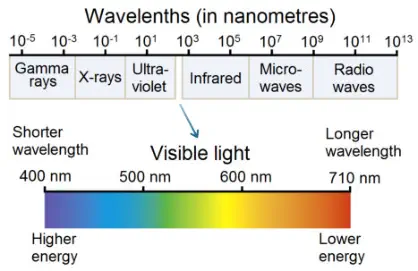
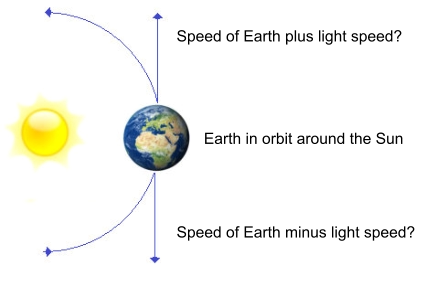
The Speed of Light: A very odd constant
Advertisement
Advertisement
The constant speed of light


Advertisement


One of the most remarkable things about light is its speed. At
299,792,458 meters per second - very close to 300,000
kilometres or 186,300 miles per second - it's the fastest thing
there is. Nothing, no matter how hard it tries, can go any faster.
The speed of light is certainly very impressive, but it has another
quality that is even more remarkable. In free space (i.e. a
vacuum) its speed is constant. At first this doesn't seem all that
odd, but, as we shall see, it's actually one of the strangest things
in the universe. Before we can appreciate the significance of the
speed of light being constant we need to learn a little more about
light itself.
The Electromagnetic Spectrum
The word "light" has a more complex meaning in physics than it
does in everyday life. The light we see by is referred to as
"visible light" and is a small part of the electromagnetic
spectrum. Radio waves, X-rays and microwaves are all part of
the same electromagnetic spectrum. The difference between
visible light and all the other forms of electromagnetic radiation is
in the magnitude of the wavelength of the light. Light can be
thought of as travelling in waves, the distance between any two
crests of the wave being the wavelength:
Each different colour that we can see has its own particular
wavelength. For example, red light has a has a longer
wavelength than blue light. White light, similar to the light we get
from the Sun or a light bulb, is a mixture of all the different
colours we can see.
If we take a look at a section of the electromagnetic spectrum we
can see that the visible light our eyes are sensitive to forms only
a small part of the total "kinds" of light we can makes use of:
The wavelength of any wave is related to its frequency (that is, if
the wave is moving, the number of crests that pass a stationary
point in a second) and its speed. These three quantities are
related by the equation:
An explanation of this equation plus worked examples is
available here.
We now have the tools we need to examine some of the more
interesting properties of light waves.
The Doppler Effect
Water waves, sound waves and light waves all share a number
of properties, including what is known as the Doppler Effect. This
says that when a wave is approaching us the length of each
individual wave is compressed and when the wave is moving
away from us the length of each individual wave is stretched out.
For sound waves this manifests itself as a rise in pitch (i.e.
frequency) for an approaching wave and a decrease in pitch for a
receding wave. This is why we hear the siren of a police car
change pitch as it passes us:
As we have noted, the speed, frequency and wavelength of a
wave are all mathematically related. If we know any two of the
three parameters we can calculate the third. For example, the
speed of the wave is calculated from a rearrangement of the
equation we saw in the previous section:
In fact, it is this equation and the Doppler effect that are behind
the "speed trap guns" used by police forces. "Light" entering the
gun has its frequency measured against a set value. The
difference in the two frequencies is fed into a modified form of the
above equation and a speed is calculated.
While water and sound waves don't have constant speeds we've
said that light does. So how can the police speed gun detect our
speed? We know that the speed of the light stays the same so it
must be the wavelength and therefore the frequency that changes.
This manifests itself as a change in the colour of the light. The
change is far too small to be seen with the naked eye, but quite
easy to detect using electronic equipment, such as a speed trap
gun.
As a light wave approaches us its frequency is "shifted" towards
the blue part of the spectrum. That is, if the light was white to
begin with it will now have its wavelength compressed in such a
way that it begins appear blue. Likewise, if the light is moving
away from us it will appear red because its wavelength is
stretched and its frequency is correspondingly lower than before.
It's only when the light source is stationary that we can see what
colour it really is.

The wavelength of each colour of light is different
We can use the Doppler effect of moving light sources to
establish something quite extraordinary about the speed of light,
and the universe.
An impossible Result?
In the mid-1800s the physicist James Clerk Maxwell discovered
the theoretical basis behind electromagnetism. His work was so
good that it's still used today in the design of electric motors and
a thousand other items that we take for granted. Your computer
probably has at least one electric motor driving the hard disk
drive and maybe another for a CD or DVD drive. Even in his day
Maxwell's equations on electromagnetism were seen as very far
reaching and of practical use in any number of applications.
There was, however, a problem.
Every time Maxwell rearranged his equations to make the speed
of light the subject and plugged in the numbers he got a very
strange result. The speed of light always came out the same,
regardless of the speed of the light source. This result seemed
absurd! It's common sense that anything cast from a moving
body will have a speed that's calculated from both the moving
body and the object.
For example, the speed of a bullet is often said to be twice the
speed of sound, that is, around 1500 mph. This is only true if the
gun that fired the bullet is stationary. If we put the gun on an
aeroplane flying at 500 mph it's obvious that the initial speed of a
bullet as it leaves the gun is now 1500 mph + 500 mph = 2000
mph relative to a stationary observer:
What Maxwell's equations seemed to be showing was that light
didn't behave like this, at least in theory. Instead the equations
stated that the speed of light was the same no matter what the
speed of the source. In other words it wasn't possible to add or
subtract the speed of the object carrying the light source:
This result was so strange that it was seen as an
embarrassment in an otherwise sound and well tested theory.
No one accepted its conclusions at face value and it was
thought only a matter of time before a better theory was found
which showed light to behave the way everyone expected it to.
For the sake of completeness I will include the equation, as
derived by Maxwell, that is now accepted as the correct
theoretical basis for calculating the speed of light:

While a full explanation of this equation is outside the scope of
these pages a few words are perhaps instructive. We have said
that light is part of the electromagnetic spectrum. The permittivity
of free space is otherwise known as the electric constant and is
derived from the force of electricity felt by two electrically
charged particles in a vacuum. The permeability of free space is
known as the magnetic constant and is derived from the
magnetic force felt on an object in a magnetic field. Light is a
combination of both of these constants; it is both electric and
magnetic, hence light is electromagnetic.

Another impossible Result?
Towards the end of the 19th Century it was fondly thought that
the work of the world's physicists was almost complete. There
were only a few odds and ends to tie up and that would be the
end of the matter. One of these odds and ends was the rather
annoying prediction in Maxwell's equations that the speed of
light was constant, and many people set out to show that this
was the nonsense it seemed to be. No one really believed that
the speed of light could possibly be constant and it was just a
matter of finding some experimental evidence to show that light
behaved the way everyone expected it to.
In 1887 two particularly ingenious experimental physicists
conducted an experiment to measure the speed of light
changing as a consequence of the Earth travelling around the
Sun. This experiment would use the Doppler effect as its basis.
The physicists were the Americans Albert Michelson and
Edward Morley, and they are now, sadly, almost always
remembered for all the wrong reasons.
Around this time it was thought, and widely accepted, that space
was filled with a transparent substance called the "ether". It was
this, it was thought, that allowed light waves to get from place to
place, just as air allows sound to travel (note that sound can't
travel in a vacuum). The arguments for the ether were so strong
that we still refer to it today. For example, we talk of radio waves
travelling through the ether, and it wasn’t such a long time ago
that many computers were connected to networks by the
Ethernet.
Using a series of mirrors and an instrument for measuring the
wavelength of light (called an interferometer) the two scientists
carried out what is now referred to as the Michelson-Morley
Experiment. They expected, as did everyone else, that they
would find that the Earth's rotation around the Sun would show
up as a colour shift in the (stationary) ether due to the speed of
light being added to the Earth's speed in the direction of orbit,
and subtracted in the direction that the Earth was moving away
from:
What they found however just didn't seem to make sense. Their
results showed that there was no difference in the speed of light
in either direction. Not only that, but they couldn't actually detect
the ether at all! Everyone, including Michelson and Morley, put
this down to experimental error. The equipment was improved
and the experiment tried again. Still the results came out the
same; the speed of light seemed to be constant! In fact, the
experiment was carried out a number of times, each time with
improved equipment and every time the results came out the
same.
With hindsight it's easy to criticise the whole scientific
community for not seeing what was staring them in the face.
This would be quite unfair, however. They were being asked to
believe something that challenged not only all of the very
successful scientific doctrine of the previous 200 years, but also
common sense itself. However, there is no evidence that the
universe is constructed in such a way that it always has to make
sense to mere humans beings! Just occasionally though, there
are human beings who look at the universe a little differently.

Enter Albert Einstein
In 1905 Albert Einstein was working as a patent clerk in
Switzerland. He always claimed he new nothing of the
Michelson and Morley experiments and this is quite possibly
true; Einstein's physics were usually carried out without
reference to experimental results. Instead he relied on his own
intuition and mathematical experimentation. His isolation from
the physics community was probably a bonus in that he was
allowed to think freely without being swayed by contemporary
ideas or doctrine.
Einstein started by asking the almost child-like question "what
would it be like to ride on a light beam?" The answer to this
simple question eventually led him to deduce his Theory of
Relativity. In order for his ideas and equations to make any
sense he had to do something no one had dared to do before –
he had to accept the constancy of the speed of light at face
value. Once this is done the constancy of the speed of light is
one of only two postulates needed for the whole of special
relativity:
Postulate I: The principle of relativity:
The laws of physics are the same in same in all inertial
frames.
Postulate II: The principle of the constancy of the speed of
light:
The speed of light (in a vacuum) has the same constant
value c in all inertial frames.
The whole of special relativity; time dilation, the twin paradox,
moving clocks running slowly, space-time and even E = mc
2
all
stem from just these two postulates. Once the speed of light is
accepted as a constant, as it had already been seen to be both
in theory and experiment, everything slots into place. That the
speed of light is constant has been checked over and over
again using ever more sophisticated equipment.
Probably the most startling demonstration of the second
postulate being correct is the detonation of an atomic bomb.
Whatever one thinks of the merits of such devices it's
undeniable that they work. The basic principle behind an atomic
bomb is that matter is converted into energy via the famous
equation E = mc
2
. This equation is derived directly from the
second postulate. There are few more convincing ways in which
a "theory" can be demonstrated to be correct.

Albert Einstein (1879 – 1955)
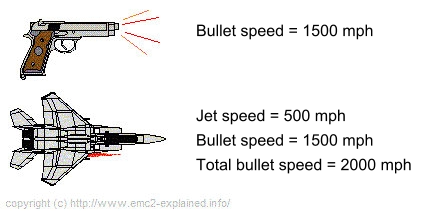
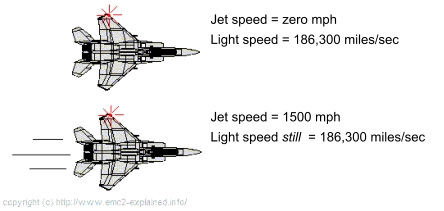
Addition of normal speeds
The speed of light remains constant


Wavelength

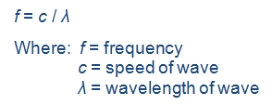
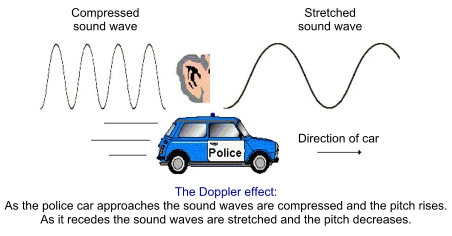

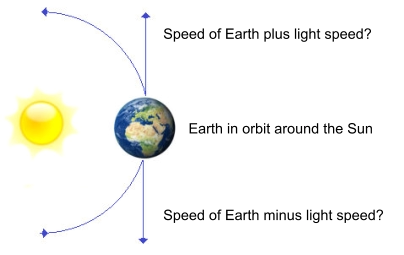
The Speed of Light: A very odd constant










